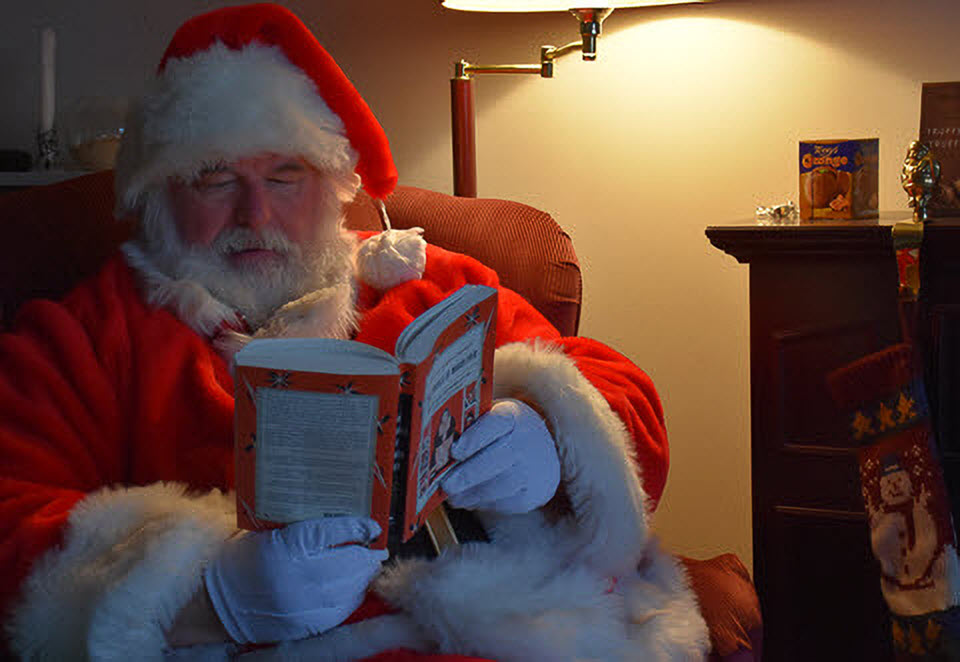Episode 198
The tradition of drinking tea, herbal infusions, and spiced beverages during the holiday season has evolved from medieval medicinal remedies to sophisticated and cherished modern holiday customs, reflecting centuries of cultural exchange, religious symbolism, and festive cheer.
Who better to describe this history than our guest today, Santa Claus?
Jolly old St. Nicholas recounts the nearly two-thousand-year evolution of holiday beverages.
Listen to Saint Nicholas
Powered by RedCircle
Spotlight

The Spirit of Christmas
By Jolly Old St. Nick
My first memories are of a magnificent seaside home on the Island of Lycia [LIE see-uh], in a place now called Türkiye [TOOR kee yeh]. It was then the land of the Greeks, who were under the rule of Rome.
Patara [PAH tah rah] was a maritime city, a city of commerce, and the capital of Lycia, [LIE see-uh] distant by road from Athens but close by sea.
Tea was unknown where I lived. In those times, we drank chilled juice, milk with honey, and wine diluted with water, all handed down from Alexander the Great, who conquered Lycia 300 years before the Christian era.
I was born to luxury but cursed by my parents’ early deaths in the plague.
Left with great riches, I devoted myself to Christianity from an early age and vowed to spend my wealth on the needy and disadvantaged children of every class. An acolyte with great religious vigor, I was sent to Myra, where, in time, I was elected bishop. Persecuted and imprisoned for years until freed by Emperor Constantine, I survived to perform miracles, rescue the innocent, protect children, and care for others with generosity.
Sainthood followed my passing in December 343 AD. I became St. Nicholas, San Nicola, and over time, Noel Baba (Türkiye), Kris Kringle, Sinterklaas, Papa Noel, Grandfather Frost (Russia), and in Italy, [BAH boh nah TAH leh] Babbo Natale (Father Christmas).
For 1,754 years, I have been the spirit of Christmas, overseeing the annual winter celebrations with joy.
Here is a brief history of what I’ve seen.
MEDIEVAL CELEBRATIONS
Five hundred years after Roman times had passed, St. Nicholas Day had become a major feast in Europe, where children received small gifts in my honor. Tea was unknown in Europe during his time, but herbal infusions made from local plants like mint, sage, and rosemary were commonly consumed during winter feasts. These herbs were valued for their warming and medicinal properties.
MONASTIC INFLUENCE
Monasteries were centers of herbal knowledge. Monks cultivated herbs such as chamomile, fennel, and mint and used them to make soothing infusions. During Christmas feasts, these drinks were offered to pilgrims and the poor as a symbol of hospitality and charity.
DURING THE MIDDLE AGES
As trade routes expanded, Europeans were introduced to exotic spices like cinnamon, cloves, and nutmeg. These spices were brewed into hot beverages such as “wassail,” a spiced cider, or ale consumed during Christmas festivities and communal gatherings. The word is from an Old English greeting, “waes hael” [WAH sul], meaning to “be whole” or “be in good health.”
MULLED WINE
In the late Middle Ages, mulled wine emerged as the forerunner of holiday drinks. Called [HIH-puh-kras] “hypocras.” Named for Hippocrates, it became a popular celebratory drink, often served warm with honey and spices.
DUTCH INFLUENCE
Dutch and Portuguese traders introduced tea to Europe in the early 17th century. By the late 1600s, it became a fashionable beverage in aristocratic circles and eventually influenced holiday gatherings. The Dutch celebrated Sinterklaas, who wears a red bishop’s robe, miter, and staff with a long white beard and visits on December 5 (the eve of St. Nicholas). Children left their shoes by the fireplace or windowsill and awakened to find treats such as oranges and candy if they’ve been good. Dutch settlers brought Santa Claus to New Amsterdam (New York), where Washington Irving, Clement Clarke Moore, and Thomas Nast established Santa’s modern appearance, arrival by sleigh and home at the North Pole.
EARLY MODERN PERIOD
In Britain and its colonies, including America, tea-drinking rituals became an essential part of social and holiday celebrations. Unique blends with spices, fruits, and herbs were prepared for Christmas and New Year’s feasts. By the 1830s, tea had spawned its own afternoon meal.
VICTORIAN ERA
The Victorians, inspired by Charles Dickens’s depictions of Christmas, embraced tea drinking as a central part of holiday gatherings. Tea rooms and homes served holiday blends featuring cinnamon, cloves, orange peel, and vanilla. Herbal infusions like spiced apple cider and cranberry tea gained popularity due to their warming properties and festive flavors. Historian Erika Rappaport writes that thousands would gather in great halls to take tea, organized by Temperance reformers who taught that “by drinking tea instead of alcohol, consumers would achieve class and gender harmony, political citizenship, and a heavenly home.”
IN MODERN TIMES
Tea companies began producing special holiday-themed teas, blending black tea with festive spices, dried fruits, and floral notes. Herbal teas such as peppermint, ginger, and rooibos are particularly popular in winter. Many cultures preserved traditional herbal infusions associated with the holidays, including Scandinavian glögg and South American yerba mate.
Santa’s legacy has endured for centuries through charitable giving, holiday traditions, and the enduring spirit of kindness and generosity that defines the Christmas Season.
Less well-known is my fondness for tea.
Recent Posts
- Darjeeling Faces A Challenging First Flush | Growers Ask for 100% Auction Sales | Two Tea Brands Raise Funding
- USAID Dismantled: Help Assess Impact on Tea Globally
- Red Sea Shipping Attacks Paused | Carlsberg Acquires UK Bottler Britvic | Kidney Mortality Rates Lower for Tea Drinkers Consuming Oxidized Tea
- Indian Tea Industry Flags Poor Imports | Chai Point Aims For Guinness Record at The Kumbha Mela | 2nd Inter Tea Garden Football Tournament in Assam This Week
- Hot Tea Gains Marketing Momentum | FDA Bans Red Dye No. 3 | Argentine Tea Awarded GI Status


